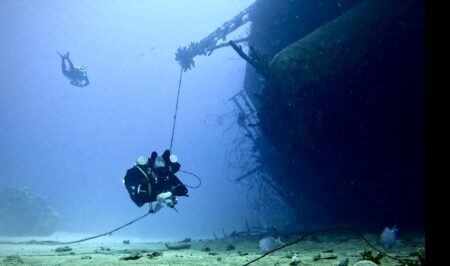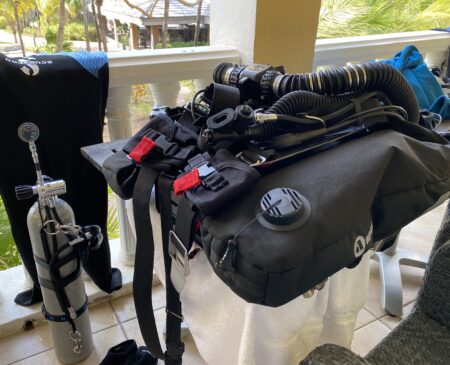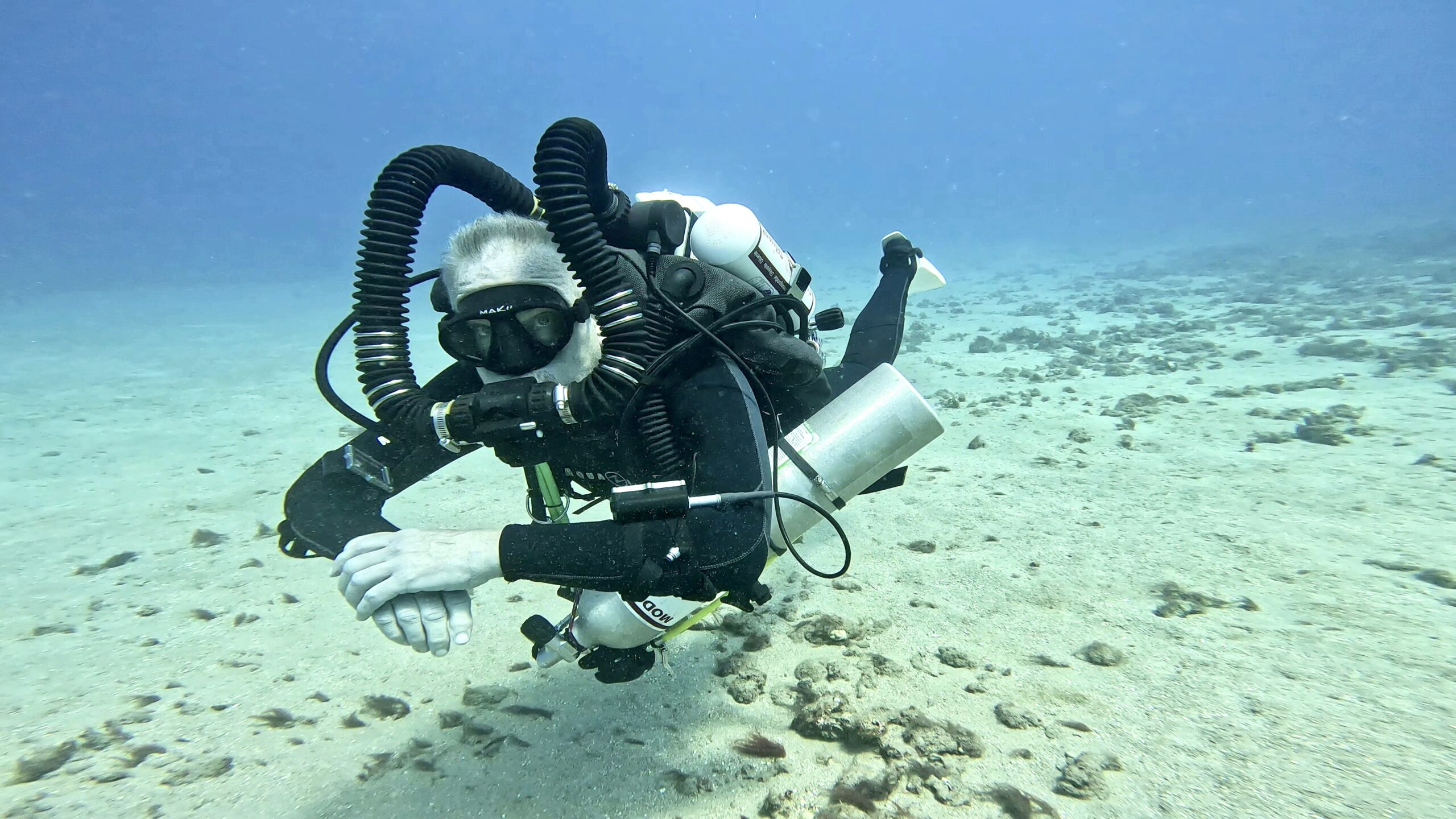Sport KISS Rebreather: Some Love and a Few Upgrades
A few years ago I wrote a post singing the praises of my trusty Sport KISS rebreather. At the time, I had made up my mind that I should probably look for something newer. Part of that is practical. Parts are scarce, and the Sport KISS is only rated to 165 FSW. To this day, I have not done a single dive in any other rebreather, so my opinion of the Sport is based entirely on how much I love diving with it.
By the way, I was motivated to write about the Sport KISS again after being sort of “mentioned” in a couple YouTube videos. Scroll to the bottom to watch. I guess, not exactly mentioned per se… Just watch and you’ll see what I mean.

The only issues I’ve ever had with my Sport KISS are related to aging Molex connectors. I personally think the sensor housing is poorly designed. O2 sensors are a pretty critical component, to say the least, yet they are held in place in a way that (a) puts strain on the wires, and (b) allows for some play.
The sensor housing is held in place with a finely threaded screw that’s driven into a piece of plastic. I’ve never stripped or broken one, but it isn’t ideal. It can also be a huge pain to take apart between dives, so I designed a 3D printed tool for that.
Diving the Sport KISS Rebreather
The Sport was manufactured with one of two available counterlung cases, either stainless steel or aluminum. The stainless steel case weighs 10.1 pounds. I like it because that weight is distributed high up the diver’s back, which is excellent for achieving perfect trim. Combined with various backplate options, the choice allows you to dial in just the right balance of the amount of weight along with where it is placed.
Your choice of tanks make a big difference too. I have multiple sets of rebreather cylinders including aluminum 13s and 19s, Faber FX15s and Faber FX23s. If I were to choose just one, it would be the Faber FX15s, but all of these have their place.
Since my first article, I’ve managed to accumulate quite a few spare parts, and two more complete Sport KISS rebreathers—one of them, aluminum.

This came about after searching for parts and the case. I was fortunate to have been approached by an individual with two complete units—one aluminum, one stainless. Both had all of their hoses replaced with Miflex, upgraded R22 sensor pods and Fischer connectors for the Shearwater Petrel EXT.
I’ll get into some of the things I’ve learned making these units dive-ready shortly.
The more I dive on a rebreather, the more I only want to dive a rebreather. I often hear people say that you have to completely relearn buoyancy control. It is only sort of true that breath-control isn’t a thing on rebreathers. As open circuit divers, we are never truly neutral. Your inhale/exhale cycle means you pass through neutral on every breath, but are only neutrally buoyant somewhere in the middle.
On open circuit, it quickly becomes habit to use breathing for buoyancy control. On closed circuit scuba, breath control won’t help you during level segments of your dive, but it is critical during descents and ascents.
During the descent, the Sport KISS rebreather uses an automatic diluent valve (ADV) that allows diluent to flow when you bottom out the counterlungs. Unless you add a manual add valve, diluent flow is most definitely managed with breath control.
During your ascent, you vent the loop by exhaling through your nose. Again, breath control…
Rebreather divers use breath control to establish the loop volume, which impacts buoyancy and ease of breathing among other things. Critically, on a KISS rebreather, your breathing and loop volume are vital components in establishing your gas mix (PO2).
I’ve read and heard other divers suggest that your need to dive the KISS in a slightly head up position to minimize your work of breathing (WOB). In my experience, that’s not been the case at all. I dive in a very level, fins-up, trim whether I’m on CCR or open circuit. Back mount single, doubles, sidemount, rebreather—I want it all to feel the same. I am freakish about my trim, and I don’t personally make any adjustments to dive the KISS.
The bottom line for me is I don’t notice any change in breathing effort when moving from level to a slightly head up orientation. Other positions, sure. Being vertical in the water makes inhaling strenuous. Upside down makes breathing even worse.
The Sport KISS is a very compact rebreather
I mentioned in my other post that in a Pelican Air 1607 case, my stainless steel Sport travels at 47 pounds. All the parts fit in the case. That includes my backplate and wing (Dive Rite XT CCR in case you want to know), plus tools, spare O2 sensors and a few other diving essentials.
Changing to the aluminum case brings the weight down to 42 pounds. I know there are other rebreathers that are very light and compact. The KISS Spirit is one of them. The KISS / Dive Talk Go is too, as are most chest-mount rebreathers. I am certain the KISS Sidewinder is even more travel friendly than my Sport.
However, these are all nontraditional CCR configurations. I’m not opposed to any of them, but it isn’t what I want for my everyday diving—especially when carrying a complex and bulky underwater camera system.
I have thought a lot about the rEvo Micro in titanium. I like that it can be configured as an mCCR, or hCCR to dive much like the KISS. I am a huge fan of titanium for metal parts in salt water. rEvo rebreathers are extremely well machined, as well as depth rated to 100m. They are also traditionally configured, which I prefer. On the other hand, some far more experienced rebreather divers than I aren’t fond of the rEvo. Then again, they don’t like my Sport either.
Every other back mount rebreather I am aware of is much larger and heavier. They are also more capable. I’d never suggest my KISS Sport is appropriate for extreme dives that are regularly made on a JJ or X Rebreather. But, within its capabilities, the Sport KISS is an awesome rebreather.
Things I don’t like about the Sport KISS
Here are some things I don’t like about the Sport. Keep in mind, it was discontinued about 15 years ago, so KISS got a lot right. For the complaints I resolved, I’ll detail what I changed. Some issues simply require compromise.
1 – I really do not like the way factory KISS Sport tank mounts work. The don’t feel solid and are curved to match the radius of Aluminum S-13s. As a result, when you use a slightly smaller diameter cylinder, they distort the plastic just enough to to make them difficult to mate with the bracket on the housing.
The original tank mounts also require big hose clamps, so changing tanks is a hassle and requires a flathead screwdriver or nut driver.
My solution was to convert the mounting system to use mini cam bands. Later, I designed a tank mount that uses the original holes and hardware, but is 3D printed. It works fantastically well—again with mini cam bands. The only downside is the printed parts tend to hold onto salt water for a while. If they were machined out of Delrin, they’d be perfect.
2 – I think it is annoying to have the loop hoses exit straight out of the top of the rebreather. There isn’t a realistic solution for this. I did switch to 20” hoses instead of the 22” ones that come standard. It helps quite a bit. Also, getting loop hose weights placed just right makes a massive difference.
3 – I already mentioned the sensor housing. There is no easy solution for this. The originals work pretty well, but I have struggled to get the wires and Molex connectors to jam in there, and I constantly worry about kinking or breaking something. I’ve started talking to my machinist brother about making better fitting, better machined parts. Hopefully, he’ll be able to find time to help.
4 – If you have a Sport KISS with the stainless steel braided hoses, I recommend changing to Miflex. Don’t get off-brand hoses for your rebreather. I’ve used an awful lot of cheap braided hoses over the years. Cheap LP hoses have a nasty tendency to curl and cheap HP hoses get dangerously stuff over time. None of them last very long by comparison. Miflex hoses really are worth the extra cost.
I had all my Miflex hoses matched to my preferences by measuring every component while wearing my rebreather in the same position as if I were underwater.
5 – The backplate mounting bolts are stainless steel carriage bolts press fit (sort of) into the counterlung case. They tend to be in the way for travel, and may or may not stay in place. I solved that by using T-nuts that have been cut down on a lathe. They thread on from the backplate side and do a good job of holding things together while you assemble your rig. It looks cleaner too.
6 – The counterlungs themselves are basically fine, but the bayonet-style fitting into the scrubber canister requires gripping it with the counterlung itself. This seems prone to wear and makes me nervous every time I install or remove them.
7 – The scrubber canister uses the same mount for the towers as it does for the counterlungs. That’s fine. What isn’t fine is they either ship too tight, or somehow shrink over time. This creates a tendency for the plastic parts to rub, gall and possibly break when simply assembling or disassembling your rebreather.
I designed a a 3D printed tool to re-fit and true the o-ring surfaces to mate together properly. If you have a Sport and struggle with these parts during assembly or disassembly, check them with a caliper. You’ll likely discover the male end is actually larger than the scrubber half it is supposed to bayonet into.
That said, this is a CRITICAL component. You can destroy your rebreather by modifying the scrubber canister. Don’t just start cutting or sanding these parts.
I know, it’s quite a list of complaints, but…
The Sport KISS is a nice rebreather to dive. The thing was discontinued ages ago and still has a following. Tooling costs were high then as they are now, and the rebreather market was even smaller back in the early days of commercial rebreathers, so I get why it feels garage-built.
Given that, the Sport is a marvel. Functionally, it is identical to KISS rebreathers manufactured today. Even many of the parts are still in use on current models. I have spent a lot of time in the water diving the Sport. I love (most) every minute.
For a long time, I have felt that the Sport KISS is a design that should be updated and refined. A more efficient scrubber, sensible loop hose orientation, better sensor housing and re-imagining of the fitting choices would make the Sport a perfect choice for a large number of rebreather divers. I’d love to hear from anyone that dives currently, or has experience diving the Sport KISS.
Finally, here are a couple YouTube mentions I think are cool
First, this guy, at 14:35 mentioned a “gentleman” in the US that polished his Sport to a mirror finish. He doesn’t say who, but he did say it looks fantastic. I have scoured the Internet and haven’t found another mirror-finish KISS Sport, so I’m quite certain that the gentleman is me. I take issue with being called a gentleman, but he’s being polite.
Next, this video isn’t about the Sport KISS at all. It’s all about the Dive Talk GO rebreather. I was simply watching the video to see what the GO rebreather is all about. One day, maybe I’ll do a demo dive in it, but I was just watching out of curiosity.
Early on, the host started a discussion about traditional rebreather bailout systems. This is what I touched on earlier. Like the KISS Orca Spirit and sidewinder, the Dive Talk GO rebreather shares a single cylinder (typically an AL40) for both diluent and bailout.
In his explanation, he brought up an image of a diver that clearly shows how a typical rebreather bailout system is attached. Low and behold, his example diver is me swimming along in my mirror-finished Sport KISS.
I am actually surprised that he chose a photo with such an ancient rebreather. As a side note, I don’t usually hang my bailout cylinder that low (I’m using almost a sidemount system for bailout these days). In any case, I had NO IDEA I was in the video and am amazed that I stumbled across it out of the blue.


